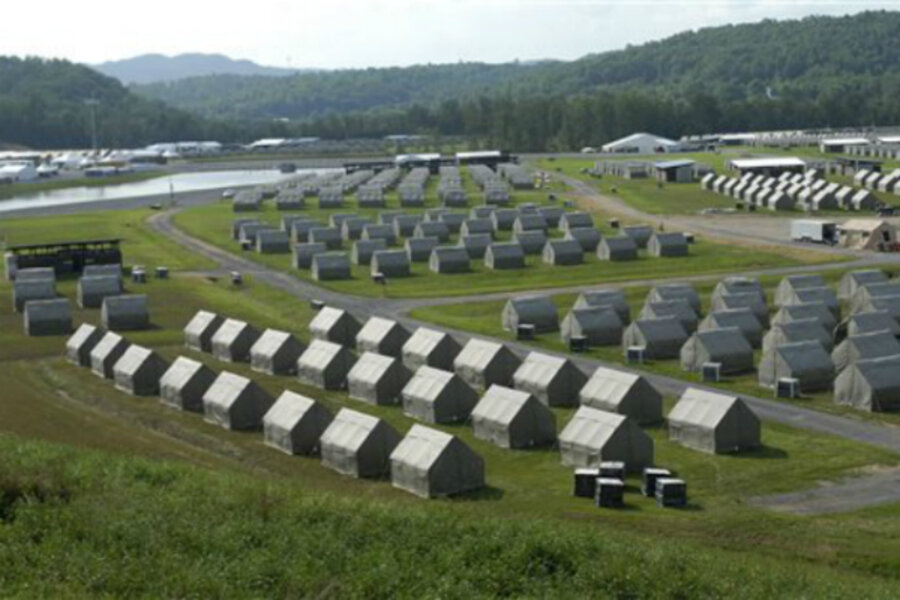Boy Scouts of America jamboree camp excludes obese Boy Scouts
Loading...
| Glen Jean, W.Va.
This year's Boy Scouts of America's national Jamboree is being billed as the most physically demanding in its history: There's rock climbing, rappelling, whitewater rafting and biking. And Scouts will go about the sprawling, hilly landscape the old-fashioned way – on foot.
Thousands of Scouts gather for 10 days starting Monday at a new location in West Virginia. Officials designed the 1,000-plus acre Summit Bechtel Family National Scout Reserve to take advantage of the Mountain State's natural assets, and they also put into place new physical fitness requirements that eliminated morbidly obese Scouts from participating.
"Part of the design in building this site was to address the need for physical fitness in our youth, which of course is a longstanding component of Scouting," said Dan McCarthy, director of the BSA's Summit Group. "We saw this as an opportunity to integrate some new challenges ... so we deliberately spread the site to enable us to encourage Scouts and basically require Scouts to move about the site by foot."
This year, 30,000 Scouts ages 12 to 20 and their leaders were required to meet a threshold for body mass index and other health factors before being allowed to participate. Jamboree applicants with a BMI – a measure of body fat determined through height and weight — of 40 or higher were deemed ineligible. Those who fell between 32 and 39.9 faced providing additional health information to Jamboree medical staff.
Nationally, about 17 percent of children ages 2 to 19 are considered obese — triple the rate from a generation earlier, according to the Centers for Disease Control and Prevention.
"We required a level of fitness in order to come to the Jamboree that we haven't required before," McCarthy said. "And that has motivated an enormous return in terms of both kids and adults getting serious about improving their health."
Soon, the Scouts will know why. Besides offering a whole lot of fun, dozens of venues will test their physical skills and fitness. At some point during the Jamboree, every participating Scout will be asked to take a 3-mile trek up a mountain.
Their reward: A barbecue waiting at the top.
"We certainly want to get the Scouts outdoors, challenge them and have a healthy lifestyle," said Gary Hartley, the Summit's director of community and governmental relations. "We talk about the three C's as kind of the pillars, and that is cardio, character and citizenship. We have all of those embodied here."
From 1981 to 2010, the Jamboree was held every four years in Fort A.P. Hill, Va. That gathering on a flatter, borrowed Army base limited the size and scope of the Jamboree's operations.
In 2009, southern West Virginia was chosen out of 80 proposals from 28 states as the Jamboree's new home. Along with being the permanent home of the national Jamboree, whose theme is "Go Big, Get Wild," the Summit will serve as one of four high-adventure camps for the Scouts and will host the 2019 World Jamboree.
While Scouts will be roughing it outdoors, Hartley said walking won't be that rough. It's 1.5 miles from the furthest tent to the center of activity at the Summit, compared to 3 miles at Fort A.P. Hill.
Even the short, casual stroll isn't meant to be boring. A 786-foot suspension bridge connecting two of the Summit's six base camps to one of the outdoor activity centers has catwalks on either side.
The Summit's offerings are numerous. There are simple activities such as fishing on four different lakes. There's also the chance to get even wetter with whitewater rafting trips and learning to scuba dive and kayak in the Summit's Olympic-sized pools.
Among the bigger, more extreme venues, there are 50 mountain bike trails. The 11 BMX tracks and jumps total the size of about five football fields. A paved skateboard park was built by the same team that designed venues for the Summer X Games, and it includes a bowl, a vertical ramp, street-style combinations and a foam pit for Scouts to try out new tricks.
"This is the exact opposite of 'no skateboards or roller blades allowed,'" Hartley said.
Some of the venue designs fit in with the BSA's motto of building Scouts' confidence because they enable the youngsters to choose what fits their skill levels. Venues at Fort A.P. Hill addressed only the average skill set.
"Those are very different approaches to what we've done here that clearly is going to excite kids and provide opportunities that we've never had before," McCarthy said.
The planning includes incorporating safety procedures into staff training and venue oversight. Scout leaders want to be careful that exercise doesn't become exhaustion or worse.
In 2005, four adult Scout leaders were killed in an electrical accident on the opening day of the Jamboree. In the four days of intense heat that followed, more than 300 Scouts and visitors fell ill. In 1997, a Scout was killed at the Jamboree after the Army Humvee he was driving overturned.







